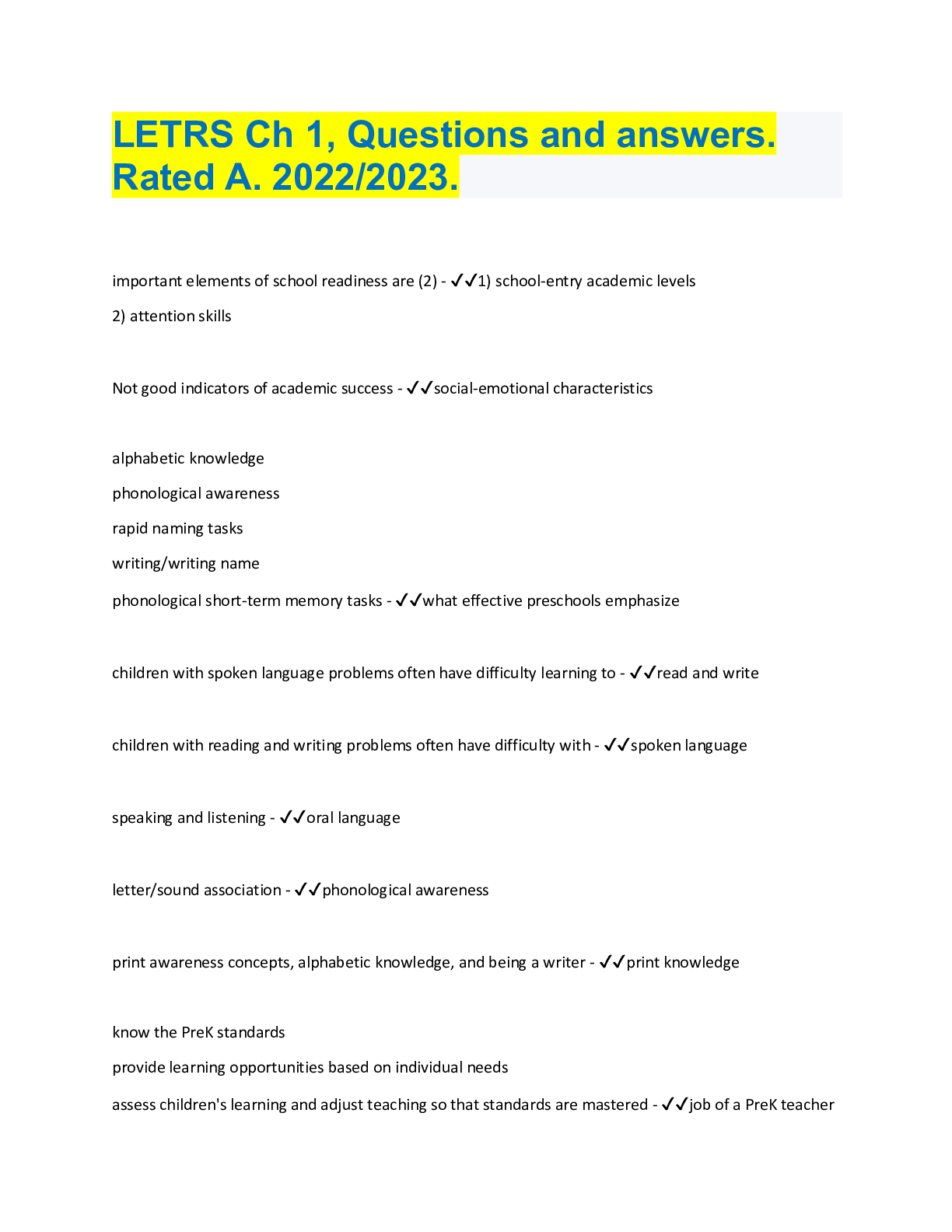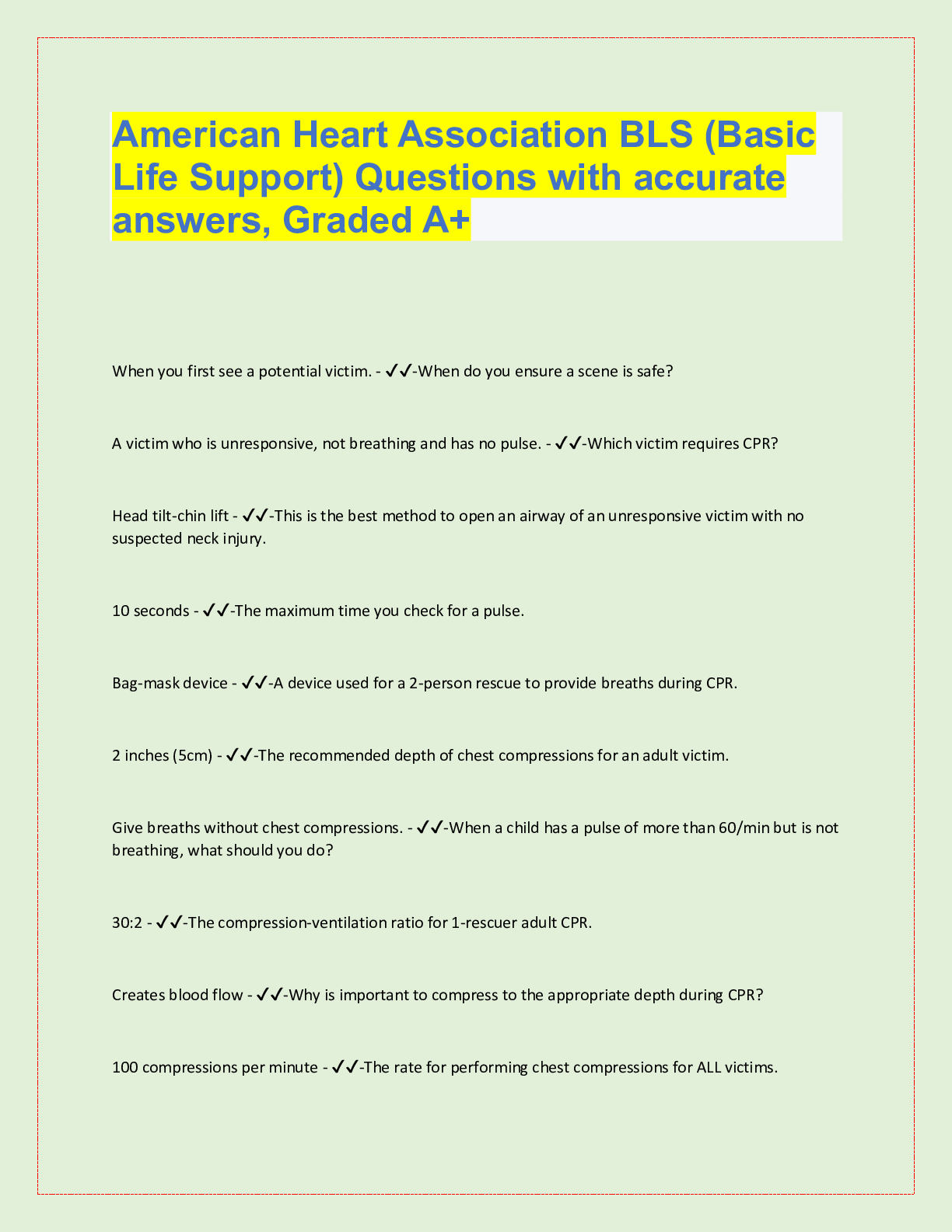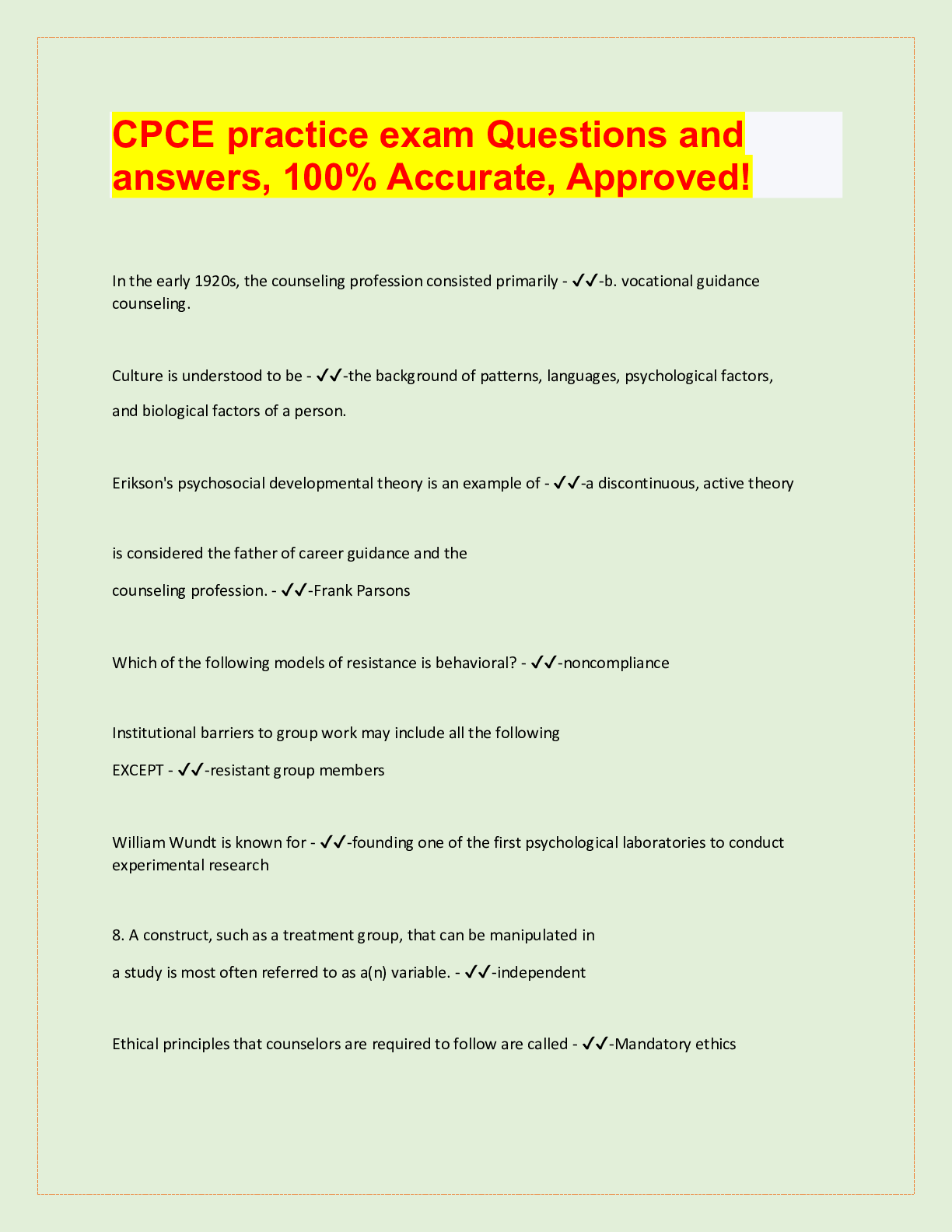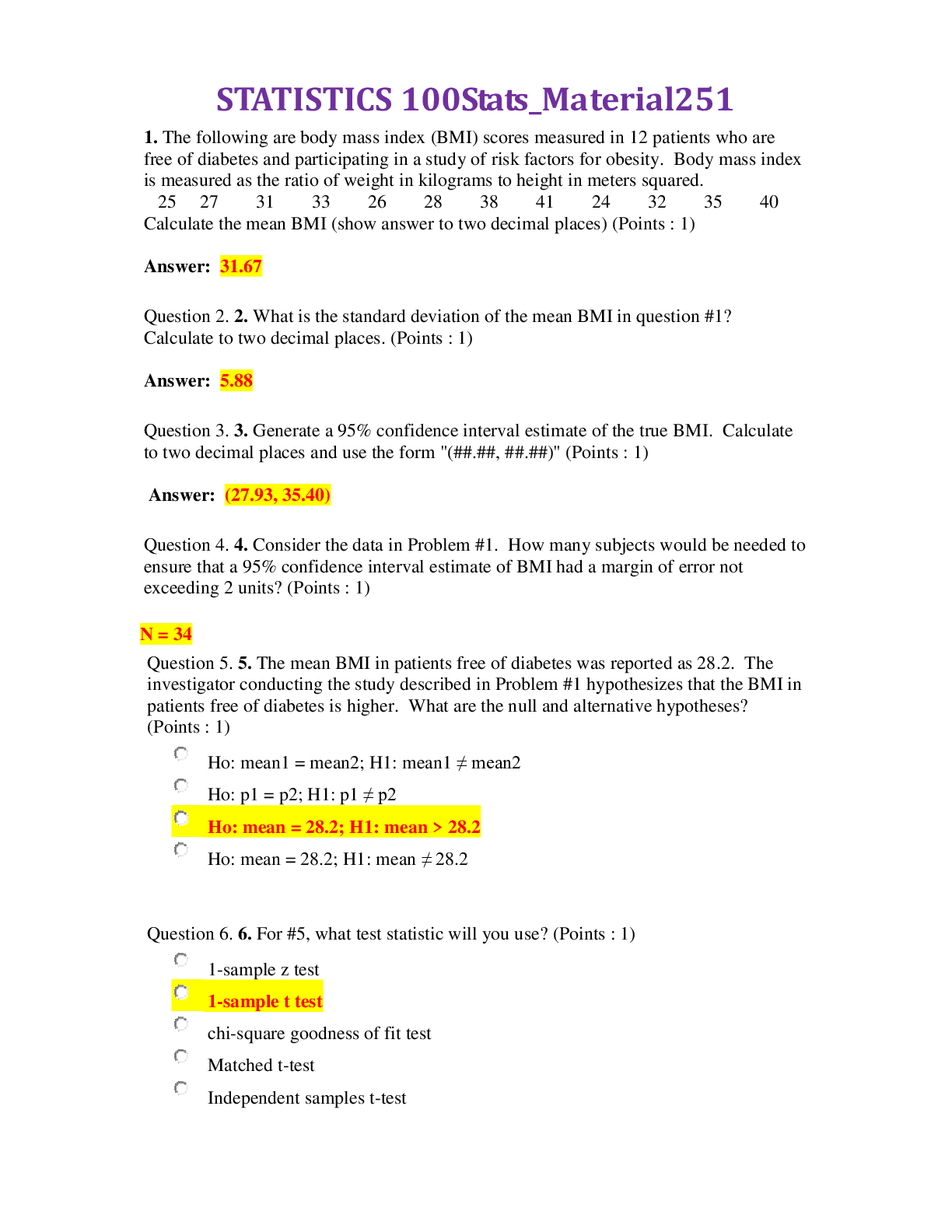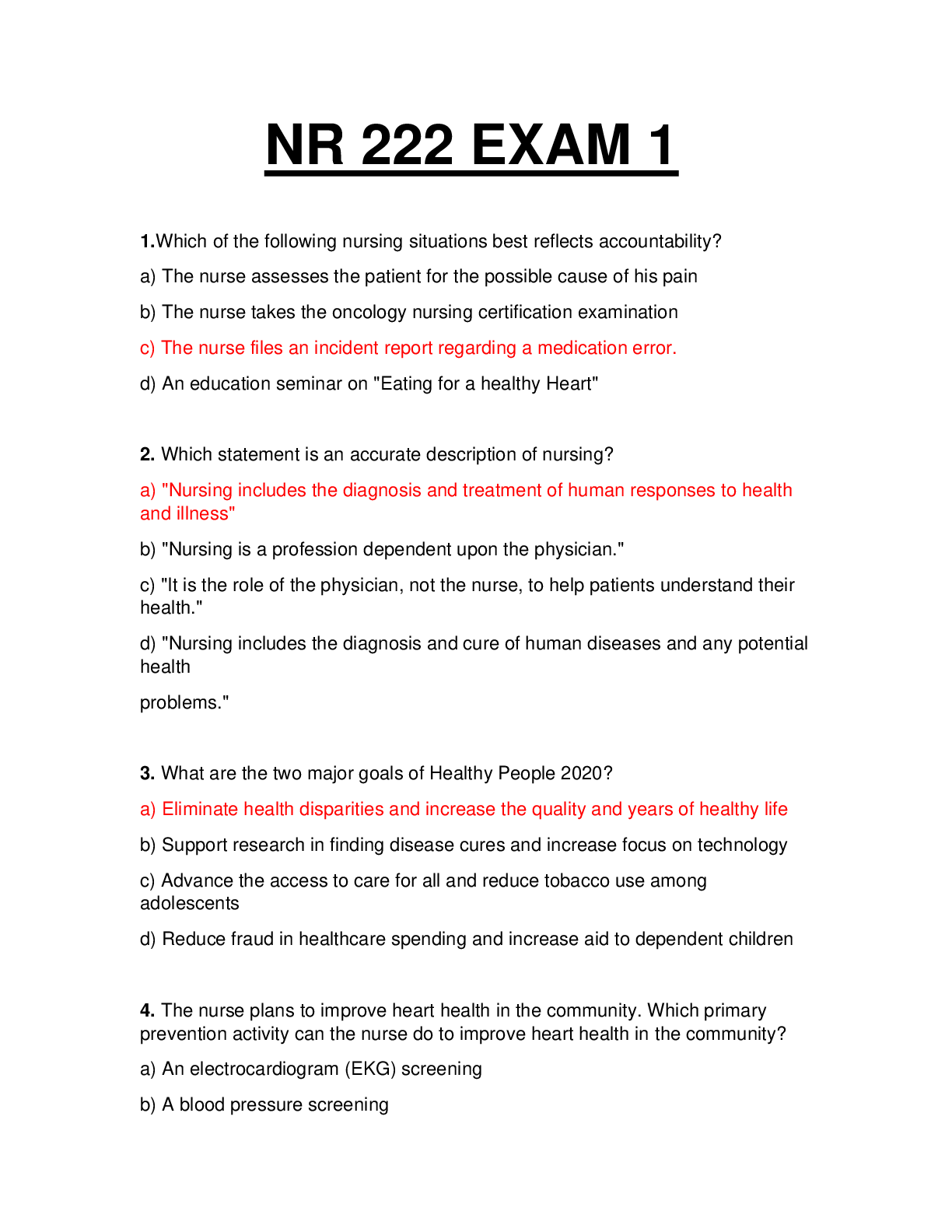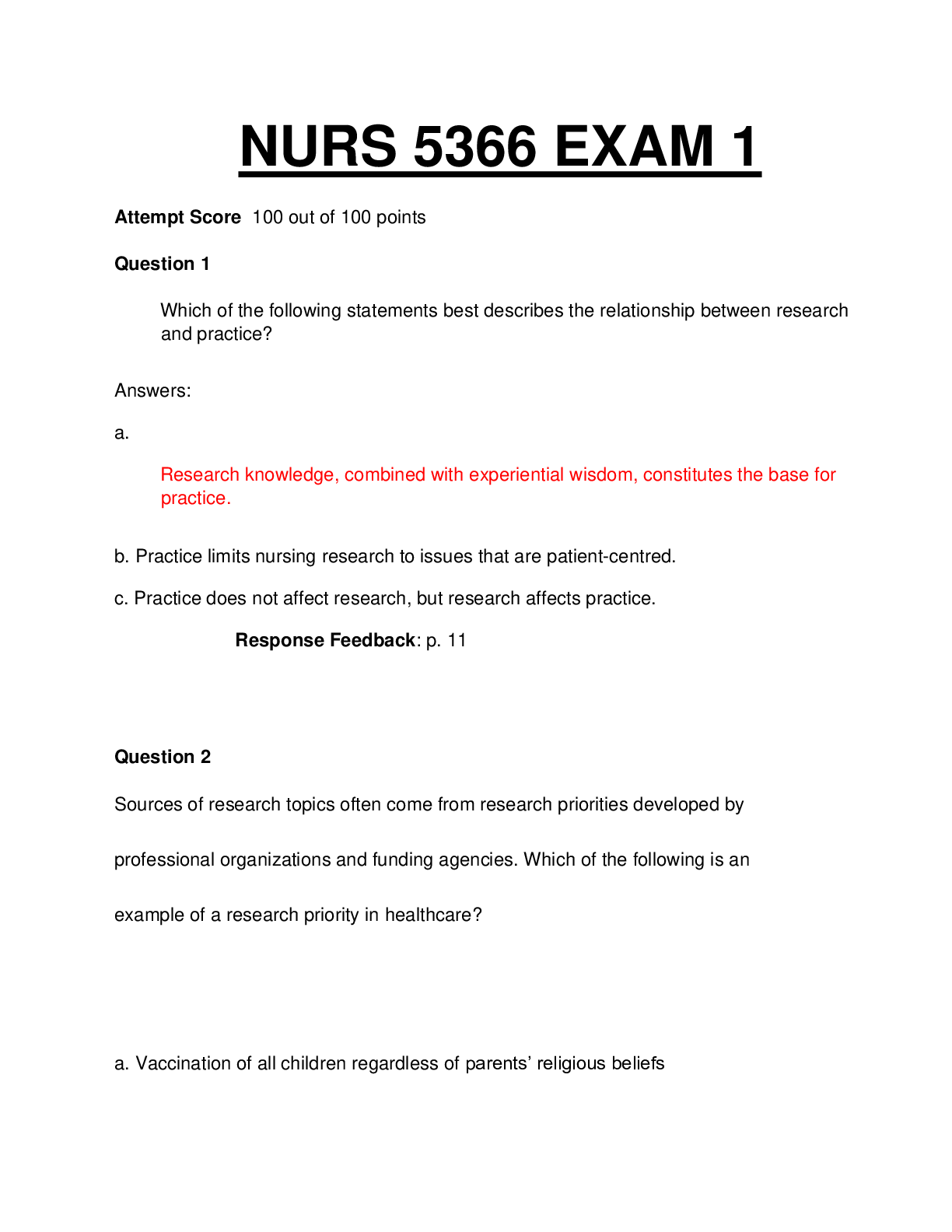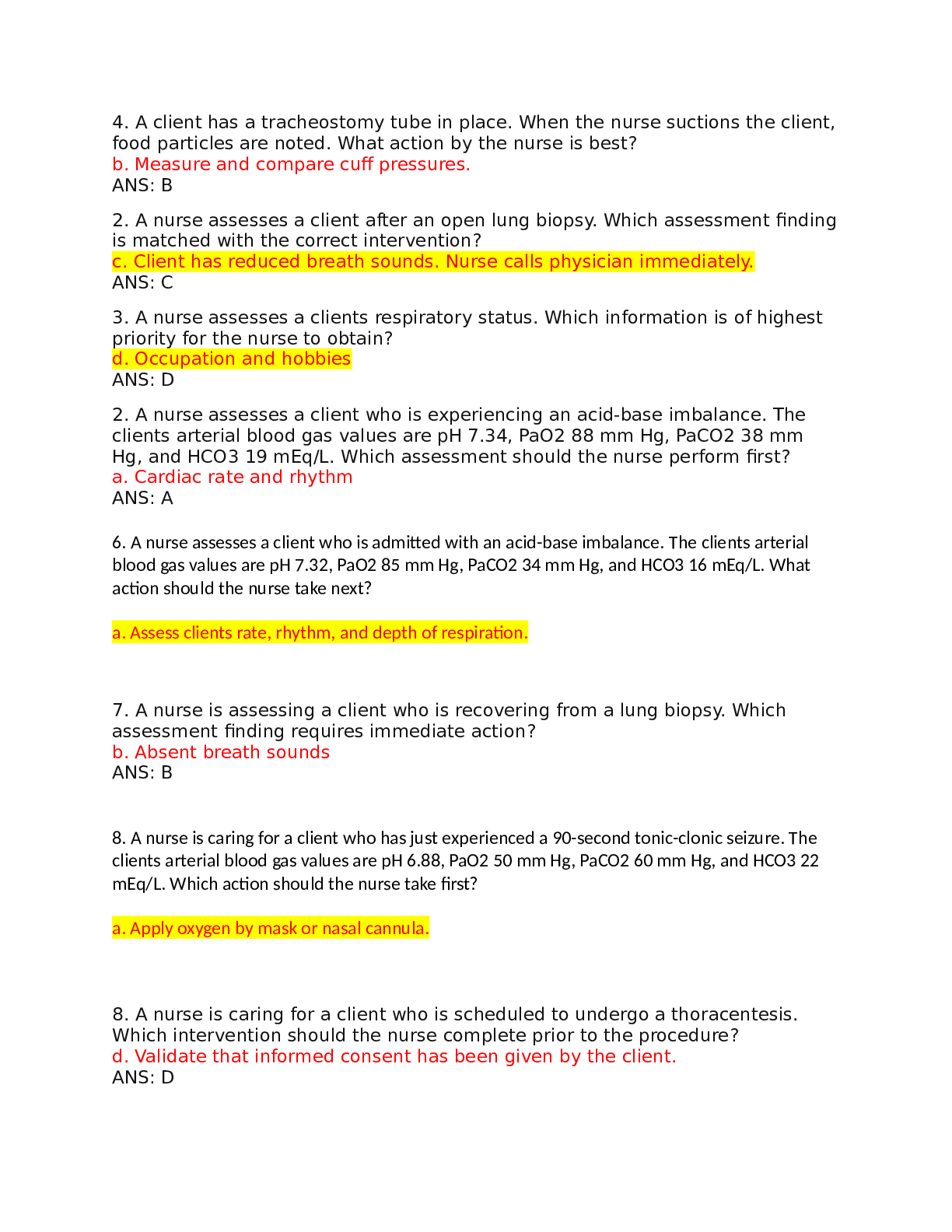Applied Science > QUESTIONS & ANSWERS > CCS Exam prep - exam 1. Questions with accurate answers, QuizBank. 100% Accurate. Rated A+ (All)
CCS Exam prep - exam 1. Questions with accurate answers, QuizBank. 100% Accurate. Rated A+
Document Content and Description Below
CCS Exam prep - exam 1. Questions with accurate answers, QuizBank. 100% Accurate. Rated A+ This patient was admitted for chemotherapy due to a primary hepatocellular carcinoma of the transplant... ed liver. What codes are assigned? a. Z51.11, C22.0 b. Z51.11, C22.0, C80.2 c. Z51.11, T86.49, C80.2, C22.0 d. T86.49, C80.2, C22.0 - ✔✔-Correct Answer: C Code T86.49 should be assigned for complication of liver transplant along with code C80.2 for malignancy associated with organ transplant. A malignant neoplasm of a transplanted organ should be coded as a transplant complication (CMS 2018a, Section I.C.2.r., 34). A 7-year-old patient was admitted to the emergency department for treatment of shortness of breath. The patient is given epinephrine and nebulizer treatments. The shortness of breath and wheezing are unabated following treatment. What diagnosis should be suspected? a. Acute bronchitis b. Acute bronchitis with chronic obstructive pulmonary disease c. Asthma with status asthmaticus d. Chronic obstructive asthma - ✔✔-Correct Answer: C "Status asthmaticus is an acute asthmatic attack in which the degree of bronchial obstruction is not relieved by the usual treatment, such as by epinephrine or aminophylline" (Schraffenberger and Palkie 2018, 346-347). . A patient is admitted with a high temperature, lethargy, hypotension, tachycardia, oliguria, and elevated WBC. The patient also has more than 100,000 organisms of Escherichia coli per cc of urine. The attending physician documents "urosepsis." What is the next step for the coder? a. Code sepsis as the principal with a secondary diagnosis of urinary tract infection due to E. coli. b. Code urinary tract infection with sepsis as a secondary diagnosis. c. Query the physician to determine if the patient is being treated for sepsis, highlighting the clinical signs and symptoms. d. Ask the physician whether the patient had septic shock so that this may be used as the principal diagnosis. - ✔✔-Correct Answer: C The term urosepsis is a nonspecific term. It has no default code in the Alphabetic Index. Should providers use this term, they must be queried for clarification (CMS 2018a, Section I.C.1.d., 22). During a coronary artery bypass surgery, the patient underwent saphenous bypass grafts; from the aorta to the left anterior descending branch of the left main coronary artery, and the left posterior descending of the left main coronary artery. The patient also underwent a repositioning of the mammary artery to the right coronary artery. Choose the best description for this procedure. a. Three aortocoronary grafts b. Two aortocoronary grafts and one mammary-coronary graft c. Two aortocoronary grafts and two saphenous bypass grafts d. Three aortocoronary grafts and one mammary-coronary graft - ✔✔-Correct Answer: B It is rare for only one coronary artery to be bypassed, and it is also fairly common to perform both an internal mammary-coronary artery bypass and an aortocoronary bypass at the same operative episode (Schraffenberger and Palkie 2018, 324-326). According to CPT, an endoscopy that is undertaken to the level of the midtransverse colon would be coded as a: a. Proctosigmoidoscopy b. Sigmoidoscopy c. Colonoscopy d. Proctoscopy - ✔✔-orrect Answer: C A colonoscopy is an examination of the entire colon, from the rectum to the cecum that may include the terminal ileum. In general, a colonoscopy examines the colon to a level of 60 cm or higher (Smith 2018, 135-136). Infusion of Herceptin, a monoclonal antibody used for treatment of breast cancer in patients carrying a certain mutation of the HER2 gene, is classified as: a. Chemotherapy b. Radiotherapy c. Molecular Targets d. Immunotherapy - ✔✔-Correct Answer: C Targeted cancer therapies are drugs or other substances that block the growth and spread of cancer by interfering with specific molecules involved in tumor growth and progression. Herceptin is a type of targeted cancer therapy also referred to as a monoclonal antibody (National Cancer Institute 2018). A patient has findings suggestive of chronic obstructive pulmonary disease (COPD) on chest x-ray. The attending physician mentions the x-ray finding in one progress note but no medication, treatment, or further evaluation is provided. The coder should: a. Query the attending physician regarding the x-ray finding b. Code the condition because the documentation reflects it c. Question the radiologist regarding whether to code this condition d. Use a code from abnormal findings to reflect the condition - ✔✔-Correct Answer: A Query the attending physician regarding the clinical significance of the findings and request that appropriate documentation be provided. This is an example of a circumstance where the chronic condition must be verified. All secondary conditions must meet the UHDDS definitions; it is not clear if COPD does (CMS 2018a, Section III, 105-106). If a patient undergoes an inpatient procedure and the final summary diagnosis is different from the diagnosis on the pathology report, the coder should: a. Code only from the discharge diagnoses b. Code the diagnosis reflected on the pathology report c. Code the most severe symptom d. Query the attending physician as to the final diagnosis - ✔✔-Correct Answer: D Coding strictly from the pathology report is not appropriate as the coder is assigning a diagnosis without the attending physician's corroboration. It is therefore appropriate to query the physician (CMS 2018a, Section III, 105-106). A 56-year-old woman is admitted to an acute-care facility from a skilled nursing facility. The patient has multiple sclerosis and hypertension. During the course of hospitalization, a decubitus ulcer is found and debrided at the bedside by a physician. There is no typed operative report and no pathology report. The coder should: a. Use an excisional debridement code as these charts are rarely reviewed to verify the excisional debridement b. Code with a nonexcisional debridement procedure code c. Query the healthcare provider who performed the procedure to determine if the debridement was excisional d. Eliminate the procedure code all together - ✔✔-Correct Answer: C Excisional debridement can be performed in the operating room, the emergency department, or at the bedside. Coders are encouraged to work with the physician and other healthcare providers to ensure that the documentation in the health record is very specific regarding the type of debridement performed. If there is any question as to whether the debridement is excisional or nonexcisional, the provider should be queried for clarification (Schraffenberger and Palkie 2018, 402). A 23-year-old female is admitted for shock following treatment of a miscarriage. The pathology report from the previous admission reveals that the patient had no decidua or products of conception in the tissue removed. This encounter would be coded as: a. O03.81, Spontaneous abortion complicated by shock b. O08.9, Complication following abortion and ectopic and molar pregnancies c. R57.9, Shock NOS d. T81.10XA, Postoperative shock - ✔✔-Correct Answer: B When a patient is readmitted because a complication has developed following discharge for a treated miscarriage, a code from category O08 is assigned as the principal diagnosis. Code O08.9 is used because the miscarriage (spontaneous abortion) was dealt with in a prior episode of care (Leon-Chisen 2018, 347-348). Most hospitals require a medical record is completed within: a. 5 days b. 10 days c. 7 days d. 30 days - ✔✔-Correct Answer: D The Medicare Conditions of Participation and the Joint Commission require that the medical record is completed no later than 30 days following discharge of the patient (Brickner 2016, 84). To correct an entry in the medical record, the provider should: a. Draw a single line through the error, add a note explaining the error, initial and date, add the correct information in chronological order b. Draw a double line through the error, initial and date, add the reason for the correction c. Draw a single line through the error, and add the correct information in chronological order d. Draw several lines through the error, obliterate the documentation as much as possible, initial and date, add the correct information in chronological order - ✔✔-Correct Answer: A If an error is corrected, the healthcare provider who made the error should draw a single line through the error, add a note explaining the error, initial and date it, and add the correct information in chronological order (Sayles 2016, 65). Further, AHIMA principles for health record documentation specify the prior statement as the proper method for correcting an error in the paper-based records in order to maintain a legally sound record. This process is based on the ASTM and HL7 standards for error correction (AHIMA e-HIM Work Group on Maintaining the Legal EHR, 2005). After a patient is discharged from the hospital, the medical record must be reviewed for: a. Inclusion of all incident reports b. Certain basic reports (for example, history and physical, discharge summary, etc.) c. Voided prescription pads d. Personal case notes from all mental health providers - ✔✔-Correct Answer: B In order to determine if a medical record is complete, it must be reviewed for certain basic reports including the presence of a history and physical, signed progress notes, and a discharge summary if applicable (Reynolds and Sharp 2016, 123-125). The incident report should never be filed in the medical record (Carter and Palmer 2016, 522); voided prescription pads are not used during a patient hospitalization; personal case notes from mental health providers are kept separate from the official record. While there are a number of documents required for the hospital medical record to be complete, the ones described in option b present the best answer (Rinehart-Thompson 2017c, 189). A patient is discharged with a diagnosis of acute pulmonary edema due to congestive heart failure. What condition(s) should be coded? a. Acute pulmonary edema b. Congestive heart failure c. Acute pulmonary edema and congestive heart failure d. Unable to determine based on the information provided - ✔✔-Correct Answer: B When a patient has pulmonary edema that is due to congestive heart failure, only the congestive heart failure should be coded (Leon-Chisen 2018, 394-395). A 65-year-old patient is admitted with pain and loosening of a left total hip prosthesis. The acetabular component has loosened and become painful. The patient was admitted for open removal and replacement of the acetabular component of the left hip prosthesis. What is the appropriate code(s) for the admission? T84.031A Mechanical loosening of internal left hip prosthetic joint, initial encounter T84.031D Mechanical loosening of internal left hip prosthetic joint, subsequent encounter T84.030A Mechanical loosening of internal right hip prosthetic joint, initial encounter T84.50XA Infection and inflammatory reaction due to unspecified internal joint prosthesis, initial encounter Z96.642 Presence of left artificial hip joint 0SP90JZ Removal of synthetic substitute from right hip joint, open approach 0SPB0JZ Removal of synthetic substitute from left hip joint, open approach 0SUA0BZ Supplement right hip joint, acetabular surface with resurfacing device, open approach 0SUR0BZ Supplement right hip joint, femoral surface with resurfacing device, open approach 0SRA0JZ Replacement of right hip joint, acetabular surface with synthetic substitute, open approach 0SRE0JZ Replacement of left hip joint, acetabular surface with synthetic substitute, open approach a. T84.031A, 0SPB0JZ, 0SRE0JZ b. T84.50XA, 0SUR0BZ c. T84.031D, Z96.642, 0SP90JZ d. T84.50XA, Z96.642 0SUR0BZ, 0SUA0BZ - ✔✔-Correct Answer: A Common reasons for revision joint replacement surgery include mechanical loosening of the prosthesis, dislocation of the prosthetic joint, fracture of the bone around the implant. In addition to the complication code, an additional code can be assigned to identify the previous joint replacement. Revision of the acetabular component involves removal and exchange of the entire acetabular component, including both the metal shell and the polyethylene, ceramic, or metal modular bearing surface (Leon-Chisen 2018, 302-303). A maternity patient is admitted in labor at 43 weeks. She has a normal delivery with vacuum extraction to facilitate the baby's delivery. Which of the following would be the principal diagnosis? O80 Encounter for full-term uncomplicated delivery O48.0 Post-term pregnancy O48.1 Prolonged pregnancy O66.5 Attempted application of vacuum extractor and forceps a. O48.0 b. O48.1 c. O80 d. O66.5 - ✔✔-Correct Answer: B When an admission involves delivery, the principal diagnosis should identify the main circumstance or complication of the delivery. The code for normal delivery cannot be used because there is a complication of pregnancy because the pregnancy is prolonged (CMS 2018a, Section I.C.15.b., 59). With regard to the implementation of ICD-10-CM, all of the following are correct except: a. ICD-10-CM was developed by NCHS b. ICD-10-CM and ICD-10-PCS was fully implemented on October 1, 2016 c. ICD-10 is already being used in the United States for death certificate coding d. The process of adoption of ICD-10-CM is specified in HIPAA - ✔✔-Correct Answer: B Full compliance is expected for claims received for encounters and discharges occurring on or after 10/1/2015 (Leon-Chisen 2018, 6). A 75-year-old female was admitted for acute myocardial infarction and underwent a diagnostic cardiac catheterization. Following the catheterization, the patient developed a thrombophlebitis documented as due to the catheter in the common femoral artery. The thrombophlebitis would be coded as: a. T81.718A, Complication of other artery following a procedure, not elsewhere classified, initial encounter b. I97.51, Accidental puncture and laceration of a circulatory system organ or structure during a circulatory system procedure c. I72.4, Aneurysm of artery of lower extremity d. I97.52, Accidental puncture and laceration of a circulatory system organ or structure during other procedure - ✔✔-Correct Answer: A Thrombophlebitis occurred in the artery where the catheterization was performed and the cause of the thrombophlebitis is documented as due to the catheterization. Thrombophlebitis resulting from a procedure is listed as T81.72. When the tabular is reviewed, this code relates to a vein. The exercise states that the artery is the location of the thrombophlebitis. Therefore a code from the T81.718 category is used (CMS 2018a, Section I.B.16, 18). A patient was admitted to the emergency department with chest pain and was diagnosed with aborted myocardial infarction with acute myocardial ischemia. There was no prior cardiac surgery. The cardiac enzymes were normal. The appropriate coding of the diagnosis for this case is: a. I21.3, ST elevation (STEMI) myocardial infarction of unspecified site b. I25.10, Atherosclerotic heart disease of native coronary artery without angina pectoris c. I24.8, Other forms of acute ischemic heart disease d. I24.0, Acute coronary thrombosis not resulting in myocardial infarction - ✔✔-Correct Answer: D Acute ischemic heart disease or acute myocardial ischemia in a patient does not always indicate an infarction. It is often possible to prevent infarction by means of surgery or the use of thrombolytic agents if the patient is treated promptly. Using the main term, ischemia, then the subterms of myocardium and acute, the alphabetic index reflects that I24.0 is the correct code for an acute myocardial ischemia without myocardial infarction (Leon-Chisen 2018, 391). A patient has nausea and vomiting with abdominal pain due to acute cholecystitis. The physician documents the following on the discharge summary: acute cholecystitis, nausea, vomiting, and abdominal pain. The correct diagnosis code(s) are: a. Acute cholecystitis, nausea, vomiting, and abdominal pain b. Acute cholecystitis, nausea, vomiting c. Acute cholecystitis, nausea d. Acute cholecystitis - ✔✔-Correct Answer: D Nausea, vomiting, and abdominal pain are symptoms of acute cholecystitis. Signs and symptoms that are associated routinely with a disease process should not be assigned as additional codes, unless otherwise instructed by the classification (CMS 2018a, Section I.B.5., 14). A patient is admitted because of congestive heart failure (CHF). During the treatment of the CHF, the patient was also found to have elevated liver function tests. The physician worked up the elevated liver function tests but was not able to determine a diagnosis. The following diagnoses should be assigned: a. Congestive heart failure with liver disease b. Abnormal liver function tests c. Congestive heart failure and abnormal liver function tests d. Congestive heart failure - ✔✔-Correct Answer: C If the findings are outside the normal range and the attending provider has ordered other tests to evaluate the condition or prescribed treatment, it is appropriate to ask the provider whether the abnormal findings should be added. Abnormal findings from laboratory, x-ray, pathologic, and other diagnostic results are not usually coded and reported unless the physician indicates their clinical significance (CMS 2018a, Section III, 105-106). A patient is admitted with hypotension due to dobutamine taken and prescribed correctly. How should this be coded? a. I95.1, Orthostatic hypotension T44.5X5A, Adverse effect of predominantly beta-adrenoreceptor agonists, initial encounter b. I95.2, Hypotension due to drugs T44.5X5A, Adverse effect of predominantly beta-adrenoreceptor agonists, initial encounter c. I95.89, Other hypotension T44.995A, Adverse effect of predominantly beta-adrenoreceptor agonists, initial encounter d. I95.81, Postprocedural hypotension T44.995A, Adverse effect of predominantly beta-adrenoreceptor agonists, initial encounter - ✔✔-Correct Answer: B This is an adverse effect of a drug as the dobutamine was prescribed correctly and the patient took it correctly. Hypotension, should be assigned to describe the condition related to the adverse effect. A "T" code should be assigned to indicate that it is an adverse effect of the drug (CMS 2018a, Section I.C.19.e., 76). A patient is readmitted two weeks after a laminectomy for spinal stenosis with a headache and documentation that the headache is due to a tear in the dura accidently that occurred during the prior laminectomy surgery. The patient is taken to the operating room for repair of the dura. The diagnosis code(s) assigned for this admission would be: a. M48.061, Spinal stenosis, lumbar region, without neurogenic claudication b. G97.41, Accidental puncture or laceration of dura during a procedure c. G97.1, Other reaction to spinal and lumbar puncture d. S34.109A, Unspecified injury to unspecified level of lumbar spinal cord, initial encounter - ✔✔-Correct Answer: B A tear in the dura that occurs during spinal surgery is not unusual and is typically repaired intraoperatively when identified. Primary closure of the dural tear is usually accomplished. Dural tears that are not discovered during surgery can result in leakage of cerebrospinal fluid (CSF), leading to CSF headache, caudal displacement of the brain, subdural hematoma, spinal meningitis, pseudomeningocele and/or a dural cutaneous fistula (CMS 2018a, Section I.B.16, 18). A patient is admitted to the hospital with shortness of breath and congestive heart failure and subsequently develops respiratory failure. The patient undergoes intubation with ventilator management. The correct sequencing of the diagnoses in this case would be: a. Congestive heart failure and respiratory failure b. Respiratory failure c. Respiratory failure and congestive heart failure d. Shortness of breath, congestive heart failure, and respiratory failure - ✔✔-Correct Answer: A Respiratory failure may be listed as a secondary diagnosis if it occurs after admission, or if it is present on admission, but does not meet the definition of principal diagnosis (CMS 2018a, Section I.C.10.b., 49). If a patient is admitted with pneumococcal pneumonia and severe pneumococcal sepsis, the coder should: a. Assign a code for only the sepsis and pneumonia b. Assign a code for the sepsis, pneumonia, and severe sepsis c. Assign only a code for pneumococcal pneumonia d. Review the chart to determine if septic shock could be used first - ✔✔-Correct Answer: B A patient with pneumococcal sepsis and pneumococcal pneumonia also has severe sepsis. Careful review of the ICD-10-CM Official Guidelines for Coding and Reporting provides information related to the coding and sequencing of sepsis, severe sepsis, and localized infection, such as pneumonia (CMS 2018a, Section I.C.1.d., 21). A patient was admitted with end stage renal disease (ESRD) following kidney transplant. The patient also had angina and chronic obstructive pulmonary disease. The diagnoses would be sequenced as: a. Kidney failure; status post kidney transplant; chronic obstructive pulmonary disease; angina b. End-stage renal disease; status post kidney transplant; chronic obstructive pulmonary disease; angina c. Chronic kidney disease, stage 5; status post kidney transplant; chronic obstructive pulmonary disease; angina d. Acute kidney failure; status post kidney transplant; chronic obstructive pulmonary disease; angina - ✔✔-Correct Answer: B Patients who have undergone kidney transplant may still have some form of CKD, because the kidney transplant may not fully restore kidney function. Therefore, the presence of CKD alone does not constitute a transplant complication (CMS 2018a, Section I.C.14.a., 56). A patient is admitted to the hospital due to a fracture of the right hip and is scheduled for an open reduction with internal fixation. The patient developed cardiac arrhythmia which results in an inability to do the planned surgery. Assign a code for the principal diagnosis. a. Status post fracture b. Cardiac arrhythmia c. Right hip fracture d. Admission for possible fracture - ✔✔-Correct Answer: C The condition after study that occasioned the admission should be sequenced first even if the plan of treatment was not carried out due to unforeseen circumstances (CMS 2018a, Section II.F., 103). Which of the following is not part of a facility coding compliance plan? a. Regular internal audits b. Audits performed by objective external reviewers c. Coding audits performed by payers d. Sharing and discussing results with coding staff - ✔✔-Correct Answer: C Reviewing the results of payers' audits is valuable, but payers are an external entity. As far as a facility coding compliance plan, incorporating internal and external auditing into the coding compliance plan has proven to be the best strategy. Internal auditing enables managers to see firsthand where their units' strengths and weaknesses lie. External auditing provides an unbiased view of a department's performance. Together, internal and external audits help coding managers build effective education plans for their units (Casto and Forrestal 2015, 44-45). A 30-year-old woman with a 6-year history of anorexia nervosa was seen in her physician's office because of significant weight loss over the past three months going from 82 pounds down to 53 pounds. She was admitted to the hospital to increase body weight and to be given nutrition counseling because of her severe malnutrition. How should this be coded? a. F50.00, Anorexia nervosa, unspecified b. F50.00, Anorexia nervosa, unspecified E43, Unspecified severe protein-calorie malnutrition c. F50.01, Anorexia nervosa, restricting type d. E43, Unspecified severe protein-calorie malnutrition - ✔✔-Correct Answer: B Code E43 should be assigned as an additional diagnosis for the severe malnutrition. For some anorexic patients, the weight loss is so severe that it leads to malnutrition. Code E43 further describes the severity of the patient's condition (Leon-Chisen 2018, 548). If a 55-year-old patient with AIDS admitted with traumatic comminuted fracture femur shaft, right leg, initial encounter. The coder should: a. Assign a code for only the AIDS b. Assign a code for the AIDS and the fracture [Show More]
Last updated: 1 year ago
Preview 1 out of 50 pages
Instant download
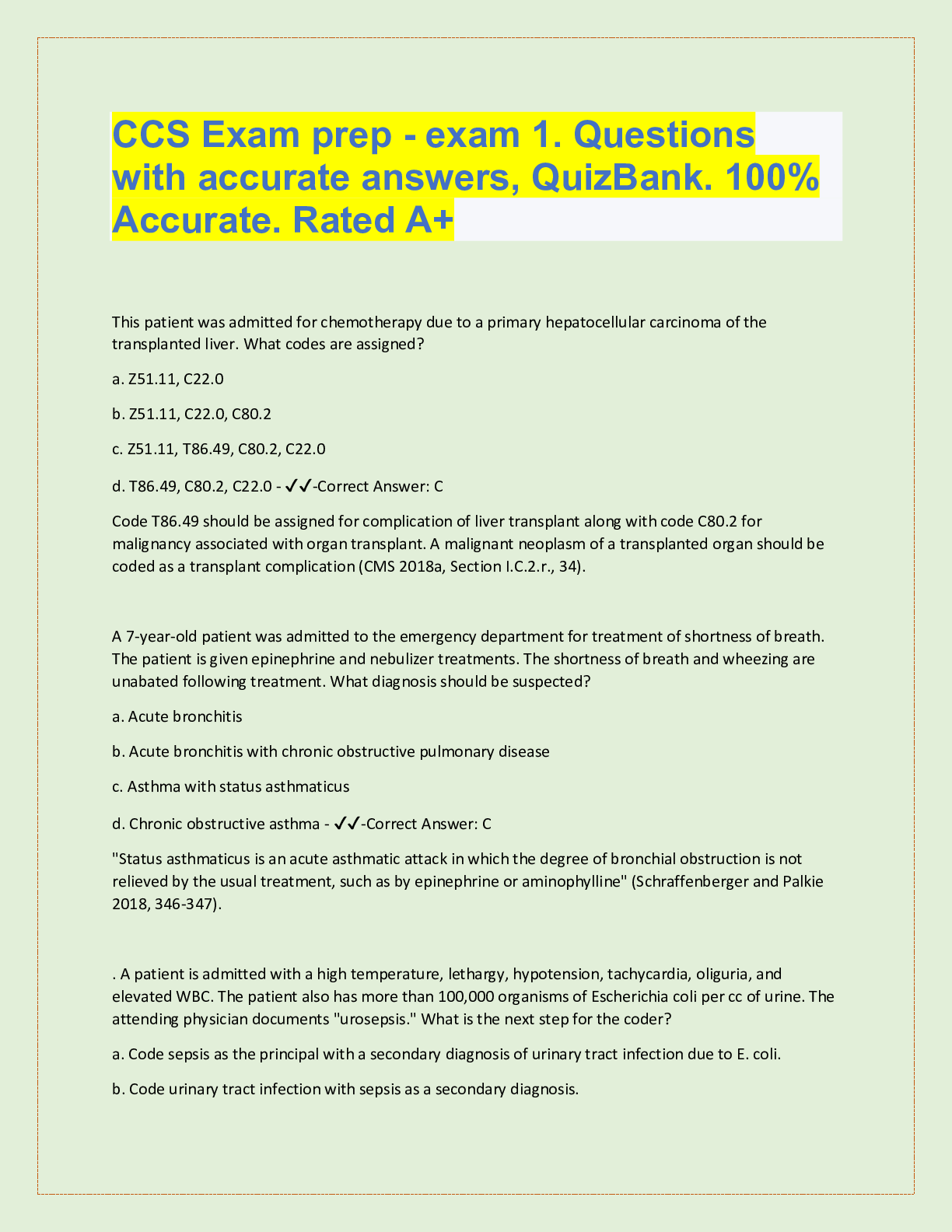
Buy this document to get the full access instantly
Instant Download Access after purchase
Add to cartInstant download
Reviews( 0 )
Document information
Connected school, study & course
About the document
Uploaded On
Mar 15, 2023
Number of pages
50
Written in
Additional information
This document has been written for:
Uploaded
Mar 15, 2023
Downloads
0
Views
74


